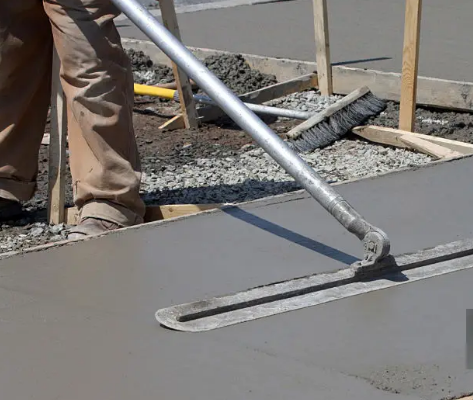Pouring a DRY vs WET Concrete Slab: Which Method Is Right for Your Project?
When it comes to concrete slab installation, one of the most important decisions is whether to pour a dry or wet concrete slab. Both methods have distinct characteristics, each with its own benefits depending on the specific requirements of your project. Whether you are building a driveway, foundation, or patio, understanding the difference between a dry vs wet concrete slab will help you make an informed decision.
In this article, we will explain what these two methods involve, the advantages of each, and how to choose the right one for your needs.What Is a Dry Concrete Slab?
A dry concrete slab refers to the method of pouring a relatively low-moisture concrete mix. This “dry mix” contains a minimal amount of water, making it stiff and less fluid than a traditional wet mix. It is commonly used for applications where a dense, solid, and durable finish is needed.
Key Characteristics of Dry Concrete Slabs:
- Low moisture content: The dry mix contains less water, resulting in a thicker consistency.
- Higher strength: Because the water-to-cement ratio is lower, the slab will be denser and more resistant to wear and tear.
- Labor-intensive: Dry mixes require more effort for compaction and leveling, making the installation process more challenging.
- Limited flow: Since the mix is less fluid, it doesn’t flow easily into molds or forms.
What Is a Wet Concrete Slab?
In contrast, a wet concrete slab uses a mixture with a higher water content. This wetter consistency allows the mix to flow more easily, making it easier to spread, level, and smooth. A wet concrete slab is typically used for applications requiring a smooth finish or when the concrete needs to be poured quickly.
Key Characteristics of Wet Concrete Slabs:
- High moisture content: The wetter mix has more water, resulting in a fluid consistency.
- Easier to handle: Wet concrete is easier to spread, level, and finish.
- Quicker installation: Wet concrete is faster to pour and requires less effort to level, making it ideal for large areas.
- Requires proper curing: Wet mixes need careful curing to avoid cracking and ensure long-term strength.
Pouring a DRY vs WET Concrete Slab: Which Is Best for Your Project?
Choosing between pouring a dry vs wet concrete slab depends on several factors, including the intended use, weather conditions, and your desired finish. Here’s a breakdown of when each method is preferable.
1. Durability
- Dry Concrete Slabs: Ideal for high-stress areas such as driveways, foundations, or industrial floors. The denser consistency provides greater durability and resistance to cracking under heavy loads.
- Wet Concrete Slabs: While wet slabs can be strong when properly cured, they tend to be less durable compared to dry mixes, especially in high-traffic areas.
2. Ease of Installation
- Wet Concrete Slabs: Easier to work with, especially for large pours. The fluid consistency allows for smoother leveling and spreading, which is ideal for projects where speed and smoothness are important.
- Dry Concrete Slabs: Requires more effort in terms of compaction and leveling. The dry mix is harder to manipulate, making it less ideal for large or fast-paced projects.
3. Surface Finish
- Wet Concrete Slabs: Perfect for projects requiring a smooth, polished finish, such as patios, floors, and countertops. Wet concrete allows for better finishing techniques, such as troweling or floating.
- Dry Concrete Slabs: More challenging to finish with a smooth surface. However, dry concrete can still provide a solid and durable base for applications where the surface finish isn’t a primary concern.
4. Weather Considerations
- Dry Concrete Slabs: Often preferred in hot or dry climates since the reduced moisture content helps prevent rapid evaporation, which can lead to cracking. This makes dry concrete more suited for arid regions.
- Wet Concrete Slabs: Require more attention during the curing process, especially in hot weather. Without proper curing, the surface can crack or weaken prematurely.
5. Cost
- Dry Concrete Slabs: Typically less expensive because they require fewer materials and less water. However, the labor required to compact and level the dry mix can increase costs in terms of time and effort.
- Wet Concrete Slabs: While easier to install, the added cost of water and labor for finishing can increase the total cost, especially for large projects.

When to Use Dry Concrete Slabs
A dry concrete slab is ideal for:
- Heavy-duty applications: For foundations, driveways, and floors where strength and durability are essential.
- Low-traffic zones: Areas that won’t see much traffic or wear, such as structural slabs or outdoor bases.
- Harsh climates: In areas with high temperatures or dry conditions where moisture retention in the mix is necessary.
When to Use Wet Concrete Slabs
A wet concrete slab is best for:
- Smooth, finished surfaces: Perfect for flooring, patios, and countertops where a polished, smooth finish is required.
- Fast projects: Ideal for large areas where quick pouring and spreading are necessary.
- Areas with less stress: For lighter-duty slabs, such as decorative floors or non-load-bearing structures.
Conclusion
Choosing between a dry vs wet concrete slab depends on your specific needs. Dry concrete is more durable, making it ideal for high-traffic areas and demanding projects, while wet concrete offers ease of installation and a smoother finish. By carefully considering the type of project, weather conditions, and desired finish, you can select the method that best fits your goals. talk to this concrete company for details.
Whether you opt for a dry or wet concrete slab, it’s essential to ensure that the mixture is properly mixed, poured, and cured for maximum strength and longevity. Consulting with a professional contractor can help ensure that your project meets industry standards and delivers long-lasting results. click here to see our another local service.